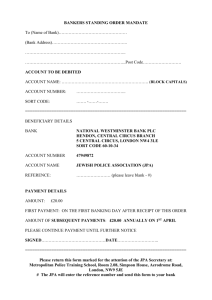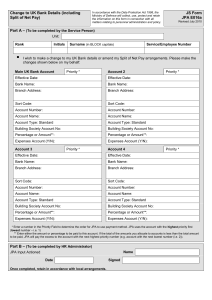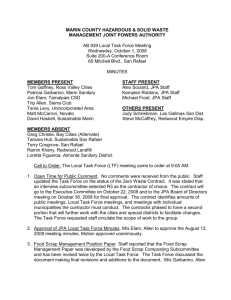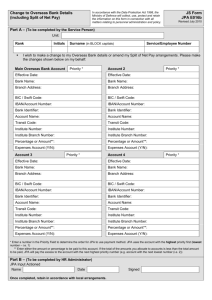Request for Master Developer Qualifications
advertisement
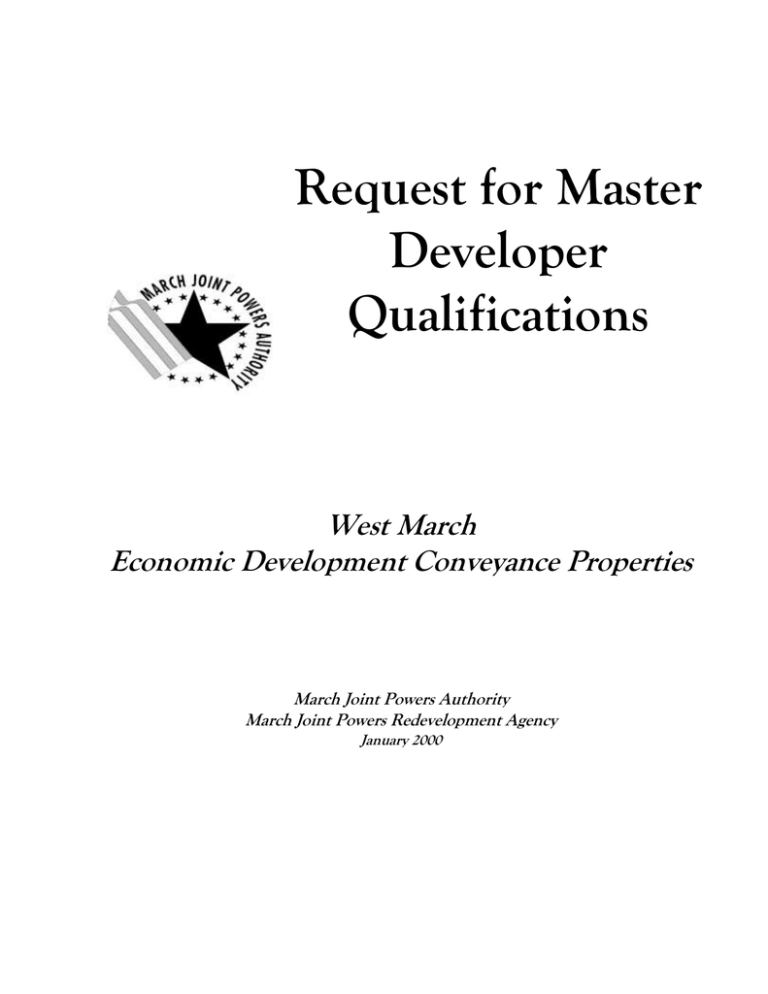
Request for Master Developer Qualifications West March Economic Development Conveyance Properties March Joint Powers Authority March Joint Powers Redevelopment Agency January 2000 1. Objectives of Base Reuse at March When March Air Force Base (AFB) was slated for realignment by the Base Realignment and Closure Commission in 1993 (BRAC 93 Commission), the March Joint Powers Commission (JPC) of the March Joint Powers Authority (JPA) was created and formulated goals and policies for the economic reuse of surplus properties. These goals and policies are contained within the “Master Reuse Plan” and are further defined for implementation within the March JPA General Plan, which was adopted September 1999. The objectives of base reuse at March can be summarized as follows: · · · · · · · support continued operation of the military base; emphasize job creation; maximize joint use of airfield for civilian aviation; create non-competing land uses; support public service facilities; preserve the historic and environmental character; and maximize potential reuse and economic development opportunities. Dependent upon the specific property, there are further goals and objectives to achieve through base reuse. They are listed as follows: · · · · · · develop a multi-modal/goods movement facility; develop land uses that create synergy; capitalize on unmet needs and opportunities of the region nearby the Base; provide for a balanced mix of land uses that contribute to the regional setting; take advantage of the existing assets at March; and maximize and enhance the tax base and generation of jobs through new, reuse and joint use opportunities. The “Master Reuse Plan” and the March JPA General Plan contain the objectives of base reuse and the goals and policies for development at March. Copies of these documents are included in the Developer’s Package. Page 1 of 17 2. Background Upon announcement in 1993 by BRAC of realignment of March AFB to an air reserve base, which was accomplished on April 1, 1996, the adjoining jurisdictions formed the March JPA to address base reuse at March AFB. 2.1 Realignment/BRAC 93 Located within the western Riverside County region of Southern California, March AFB encompassed approximately 6,500 acres straddling Interstate 215 (Highway 395) just south of Highway 60. March AFB was first established as a military installation in 1918 and has operated almost continually since. In July 1993, March AFB was selected to be realigned, and subsequently it was converted from an active duty base to an Air Reserve Base, effective April 1, 1996. The decision to realign March AFB resulted in approximately 4,400 acres of property and facilities being declared surplus and available for disposal actions, and the airfield facilities were declared to be available for joint use by accommodating civilian aviation. Prior to base realignment, the base employed more than 9,000 military personnel and civil service employees. The existence of the base in its pre-realignment condition contributed an estimated $500 million annually to the regional economy. With the announcement of realignment, the regional economic loss with the change in military mission at March was immediately recognized. While base realignment and the associated loss to the region came at an inopportune time, the opportunities relative to the planning and implementation of new uses and providing for unmet needs of the region presented an unexpected opportunity. The March JPA has planned and is implementing new uses for currently vacant lands, reuse of existing facilities, and joint use of the airfield facilities for the development of an air cargo facility (March Inland Port Airport). In short, long-term economic gains in the form of developing a civilian air cargo center, coupled with the growth and development of an employment center, will ultimately account for upwards of 38,000 new jobs upon buildout. 2.2 LRA Functions The March JPA is a public entity created solely for the purpose of addressing the use, reuse, and joint use of realigned March AFB. The four individual public entities that cooperatively formed the JPA are the cities of Perris, Moreno Valley, and Riverside and the County of Riverside. The JPA was created by separate resolutions of the four jurisdictions in September 1993. Page 2 of 17 The JPA is governed by the provisions of the Joint Powers Agreement that created the Authority. The JPA Agreement created the March Joint Powers Commission. The Commission is the decision and policy making body for the Authority. It consists of eight elected officials (two from each of the four jurisdictions). In addition to completing the organizational requirements of initiating a new governmental jurisdiction, the JPA quickly assumed the leadership position in looking toward the future of March, and it was designated officially by the federal government as the Local Redevelopment Agency (LRA). Page 3 of 17 The March JPA, in addition to being designated as the federally recognized reuse authority for the former active duty base, has also assumed other responsibilities that will allow it to better address its goals of job creation and economic development. 2.2.1 California Redevelopment Agency. With the formation of the March AFB Redevelopment Project Area, which includes the entire 6,500 acre former active duty base area, and approximately 450 acres adjacent to the base in the industrial area of the City of Moreno Valley, the March Joint Powers Redevelopment Agency was established. 2.2.2 Land Use Authority. On March 11, 1997 land use authority was transferred to March JPA from the County of Riverside. The March JPA has adopted development and building codes and standards. The March JPA General Plan was completed by the March JPA in accordance with state statutes, and an associated Master Environmental Impact Report was approved by the JPC. The March JPA General Plan is designed to implement the “Master Reuse Plan” and related activities. 2.2.3 Airport Authority. March Inland Port Airport Authority (MIPAA) is a separate entity created under the governance umbrella of the March JPA. MIPAA is responsible for the development and operation of the March Inland Port (MIP), a joint use aviation facility targeted for air cargo operations. 2.3 Economic Development Conveyance The March JPA has submitted to the Air Force Base Conversion Agency (AFBCA) an Economic Development Conveyance (EDC) application for surplus properties at March which are not otherwise being conveyed by some legal means. The March JPA will acquire surplus buildings and vacant property at no cost from the AFBCA through this EDC process. The property on West March can be summarized as follows: 2.3.1 South Van Buren. West March (west of I-215) is bisected by Van Buren Boulevard, which links the base and significant population in Riverside and unincorporated areas to the interstate. Property south of Van Buren is characterized as primarily vacant and undeveloped land which is adjacent to the consolidated land fill site and the General Old Golf Course. The South Van Buren EDC parcel consists of approximately 950 acres. It is generally defined by the Air Force for conveyance purposes as follows: 1 Parcel I-1: Parcel I-3: 1 Existing General Archie J. Old Golf Course, including a clubhouse, the maintenance building, the cart barn, and about 300 acres of property, including the golf course itself; Land fill site which is planned for regional recreation uses; and Property included in the EDC application, but not included within the land available for a Master Developer Proposal Page 4 of 17 Parcel K-2: Vacant land planned for new development in accordance with the March AFB “Master Reuse Plan” and the March JPA General Plan. 2.3.2 North Van Buren. On West March (west of the I-215 freeway), north of Van Buren is the former Arnold Heights housing complex and vacant property with abandoned concrete pads from the days of Camp Haan. This parcel consists of approximately 300 acres. It is defined by the Air Force as follows: Parcel K-3: Includes undeveloped land north of Arnold Heights, 586 abandoned housing units, several abandoned community buildings, an un-maintained neighborhood park, land fronting Van Buren Boulevard, and Chapel #2. 2.3.3 Stephens’ Kangaroo Rat. On West March, extending north from Van Buren Boulevard to Alessandro Boulevard is 1,187 acres denoted within the November 1999 final Biological Opinion as habitat for the Stephens’ Kangaroo Rat (SKR). This parcel is defined as follows: 1 Parcel F: Includes the former Weapons Storage Area, the former dog-training area, several water towers, and significant undeveloped property incorporated within the SKR Habitat Conservation Plan as part of the March-Sycamore Canyon Core Reserve. It is for the planning and development of property included within the EDC application on West March that the March JPC desires to retain Master Developer(s) or Development Team(s). Page 5 of 17 3. Location and Use of EDC Properties The goals of the “Master Reuse Plan” focus on job-generating land uses and economic recovery. The following is a synopsis of the land uses slated for the EDC parcels included on West March as defined in this document: EDC Parcel Parcel # Land Use Status South Van Buren I-1 Park/Recreation/Open Space Improved with 18-hole golf course. I-3 Park/Recreation/Open Space Consolidated landfill site to be developed for regional recreation facilities. K-2 Business Park Capacity for ~2.5 million sf. North Van Buren K-3 Business Park, Office, Commercial, Industrial, & Destination Rec. Demolition of Arnold Heights, with a capacity for ~2 million sf. Stephens’ Kangaroo Rat F Business Park, Office and Industrial Capacity for ~4 million sf. The definitions for land use designations pursuant to the Base Master Reuse Plan and the March JPA General Plan are summarized as follows: · Business park uses include administrative, financial, commercial service, governmental, and community support services; research and development centers; light manufacturing; vocational education and training facilities; business and trade schools; and emergency services. Business Park areas are generally served by arterial roadways, providing automobile and public/mass transit access. These areas are characterized as major employment concentrations. · Industrial uses may support a wide range of manufacturing and non-manufacturing uses ranging from warehouse and distribution facilities to industrial activities. Uses supported include warehousing/distribution and assemblage of non-hazardous products and materials or retailing related to manufacturing activity. Uses may include open storage, fuel storage, office/industrial park; light industry; manufacturing; research and development centers; maintenance shops; emergency services center; solid/liquid waste facilities; vocational education and training facilities; and business and trade schools. · Office uses include business activities associated with professional or administrative services. Activities can consist of corporate offices, cultural and community facilities, financial institutions, legal and medical services, and other similar uses which together represent major concentrations of community and employment activities. Uses may include office parks, office buildings, and educational and training facilities. Some limited retail and commercial service uses are permitted. · Mixed uses include a variety of complementary land uses; including commercial, business park, office, medical, educational and vocational, research and development, and services. Page 6 of 17 · Commercial uses within this designation include retail and service-oriented business activities serving the area. Commercial uses include retail establishments, shopping centers, administrative, financial, service and government offices. · Destination Recreation provides for the unique opportunity to develop a commercial attraction that markets at a recreational regional basis. Uses include theme parks; amphitheaters; exposition centers; or other commercial-based attraction other than general retail services. · Parks/Recreation/Open Space land use designation applies to all passive and active park or recreation areas whether private or public. Active recreation activities include recreation facilities, equestrian centers, golf courses/driving ranges, indoor/outdoor athletic facilities, and public parklands. Passive activities include natural preserves, along with designated and natural open space. Maps of the EDC properties are included within this request as an attachment. Page 7 of 17 4. Master Developer Opportunities West March offers varied development opportunities on approximately 650 acres south of Van Buren and 300 acres north of Van Buren at Interstate 215. The north Van Buren site has frontage for 2 miles along I-215 and the San Jacinto Rail Branchline which is adjacent to the interstate. The site has opportunity for passenger rail access via the planned expansion of the MetroLink system between Riverside, Perris, and Hemet. March has also been identified as a terminus for the proposed mag-lev, high speed rail system now under consideration for Southern California. The Base Reuse Plan and March JPA General Plan both note the focus for a multi-modal/goods movement facility at March, taking advantage of the opportunity for a linkage of land uses on West March to the anticipated March Inland Port air cargo operations. The former base’s family housing units at Arnold Heights are situated on a significant portion of this property. It is the policy of the March JPC to submit an application for federal assistance from the Department of Commerce, Economic Development Administration, for site preparation of the Arnold Heights property. This would include the removal and disposal of the former housing units, the associated buildings and recreational facilities at Arnold Heights, the Chapel #2 building, and the removal of the existing substandard utility systems. The south Van Buren property is relatively vacant and undeveloped land that is slated for land uses that would foster significant new job creation. The site has a small willow riparian area that is habitat for the Least Bells vireo, an endangered bird. Additionally, a portion of the site is a consolidated landfill with a cap that was created as a function of the base environmental clean-up plan. There are limitations on the development of this property. This portion of the property is slated for park/recreation/open space to accommodate this land use restriction, and there is the possibility of partnering with the March JPA’s member jurisdictions on the development of this property as a regional recreation center. The development program envisioned for March is outlined within the “ Master Reuse Plan” and the March JPA General Plan. An understanding of these documents is critical to a successful submittal to the March JPA. The “Master Reuse Plan” and the March JPA General Plan have been carefully developed by the March JPA and its member jurisdictions to address the development and job creation goals of the base reuse planning process. The Environmental Impact Statement for the Reuse Plan and the certified Master Environmental Impact Report for the March JPA General Plan have been prepared based upon the uses, densities, programs, and goals and policies of these plans. 4.1 Definition of a Master Developer A master developer would be responsible for the planned development of land and infrastructure on a given site. This would include infrastructure and utilities planning, site preparation, the identification of end users, and the potential building of product for tenants. Put another way, the master developer is responsible for the "horizontal development" and the vertical development of the site, including meeting the needs of tenants. The master developer is responsible for managing the development and disposition of the site from initiation to final buildout, overseeing site preparation Page 8 of 17 and infrastructure development, financing, marketing, and asset management. The March JPA is particularly desirous of soliciting a Master Developer(s) that: · · · · have the ability and the patience to undertake extensive planning studies to address infrastructure concerns and land development issues; have the ability to finance or obtain financing to begin the development process; have relationships with other professional firms necessary to build a complete development team; and have relationships and/or resources to attract actual job-producing tenants, either via land sales to users or build-to-suit facilities for tenants. Speculative land development, land sales for investment purposes, and the speculative construction of facilities are not desired. 4.2 Master Developer Policy In May of 1996, the March JPC formally adopted a policy for having a Master Developer for March. The reason stated for the adoption of this policy at the time was “to address the development opportunities and needs for private capital as the Joint Powers Authority prepares for the transition of property from the Air Force to the community.” A copy of the Master Developer Policy is included in the Developer Package. Page 9 of 17 5. Purpose of RFQ The March Joint Powers Commission, acting as the Board of the Redevelopment Agency, is now soliciting a Request for Qualifications from potential developers who are interested in pursuing development opportunities for West March as outlined in the “Master Reuse Plan” and March JPA General Plan. The March JPA is seeking master developer(s) or development team(s) for the Economic Development Conveyance properties on West March as identified in this document. The March JPA intends to review the RFQ submissions, rank them based upon the criteria in the RFQ, conduct interviews, and either select the most qualified developer, if one emerges as clearly the most qualified, or issue a request for development proposals (RFP) from the most qualified developer team(s). Successful master developer(s) may be invited to enter Exclusive Right to Negotiate (ERN) or Disposition Development Agreement (DDA) with the March Joint Powers Redevelopment Agency. Page 10 of 17 6. Responsibility of Master Developer It will be the responsibility of a Master Developer to plan, develop, or arrange for the development, sale, lease, and/or manage development of each development site. Each of the development sites is to be developed by the master developer or a developer selected by the master developer. Master planning/ specific planning and the acquisition of land use entitlements will be the responsibility of the master developer. The March JPA is expecting a master developer to demonstrate its ability to address the following requirements: · Ability to secure tenants and market the property to end-users. Developer should address the types and levels of jobs, and the approach to secure tenants that best match the employment opportunity goals and objectives as outlined in the Base Reuse Plan and General Plan. · Schedule of development performance and schedule of development through a market analysis that depicts absorption and tenant mix for the project area. Ability to secure and post performance bonds. · Identification of performance schedule, milestones, strategy, and ability to meet a schedule of performance. · Analysis of potential synergetic land uses and tenant relationships, in particular to addressing and providing for unmet opportunities associated with the development and operation of March Inland Port. · Understanding of reuse goals and objectives, and means of how the plan will meet and implement those goals and objectives. · Financial capability of the firm and a sound financial plan that identifies funding sources, financing options for infrastructure and facilities development, and additional tools available which could be utilized to implement the plan. · Demonstrate a Development Phasing Plan that can subsequently be supported through a Capital Improvement plan. · A conceptual Master Development Plan for the property, and demonstrate its consistency with the Base Reuse Plan and March JPA General Plan. This plan should delineate the components, planning tools and means of implementing such plan for the property. · Provide the components of the Team, and how the project can be moved from inception to longterm completion and execution. List all members of the group and their respective capabilities and responsibilities. It is imperative that the team is complete with proven expertise to fully execute the plan. Qualification of each team component should be provided, along with references. · Provide definition of the Key Elements of the Proposal. Page 11 of 17 7. Submission Requirements Interested master developers (or teams) should submit ten (10) sets of materials containing the following information: 1. Development Entity Identify entity which would contract or otherwise enter into foramal relationship with the March JPA, including all the joint ventures/limited partners indicating respective percentage interests. Include a complete listing of names, addresses, phone numbers, email addresses, and FAX numbers for all partners. 1. 2. 3. State intended role of each development partner in the implementation of the development and the responsible entity in the organizational structure for the ongoing management. Name principle in charge. Include resumes of key individuals who would implement this project. 2. Development Team Identify key consultants and provide a summary of relevant experience. 3. Financial Capability Submit any publicly available financial documentation, such as annual reports, which describe the company’s financial capability. Please do not submit any confidential information. After review of the submissions, the Agency may request the following detailed financial information of selected development teams. Do not submit this information unless specifically requested. 1. 2. 3. 4. Composition of real estate portfolio by project and land use in each project. Comparable recent experience (last 2-3 years) in securing financing detailing type of project, financing sources, level of funding and closing dates. List of projects currently under planning and development including status, development schedule, and financial commitments required of developer. Developer Experience Describe relevant project experience, particularly with military base reuse or large-scale urban mixed use developments, including the following information for not more than five projects: 1. 2. 3. 4. 5. 6. 7. 8. Location; Size, tenant mix, and anchor tenants; Development time line (from selection/site control to stabilized occupancy); Project cost and capital and financing sources used; General description/history including role of development entity, unique challenges of project, occupancy history; Current management/owner contact; Involvement of public entities, including financial assistance required, if any. Describe role of public sector in each project; and Four (4) references, one of which must be a bank reference, including name, title, company, institution or agency and telephone numbers and project connection. Page 12 of 17 5. Implementation Process Description Based on you review of the materials contained in the Developer’s Package, provide description, in not more than five (5) pages, of how your team, if selected, would undertake implementation of base reuse on the West March EDC properties. Describe your approach to staffing, approach to raising capital, phasing, infrastructure improvements, development of community outreach and support, working with the March JPA, and other topics you deem to be of project relevance. 6. Deposit A Twenty-Five Thousand Dollar ($25,000) deposit, in the form of a cashier’s or certified check, is required with the qualifications submission. The checks will be held by the March JPA and returned to all developers not selected for exclusive negotiations. This deposit is non-refundable for the selected developer. FORMAT: Proposals must be organized and tabbed consistent with the submittal requirements as outlined above. The submittal must consist of 8½” x 11" sheets and 11"x 17" fold-outs as necessary. Submittal Deadline Qualifications must be parcel or hand delivered to Chris Buydos, Assistant Executive Director, March Joint Powers Authority at 3430 Bundy Avenue, Suite 107 (Building 3408), Riverside, CA 92518, or delivered by U.S. mail service to P.O. Box 7480, Moreno Valley, CA, 92552 no later than 3:00 p.m. April 24, 2000 . Qualifications received after 3:00 p.m. April 24, 2000 will not be considered. The March JPA reserves the right to request additional information during the evaluation of responses, and to reject any or all proposals. Contact Information For more information contact Chris Buydos, Assistant Executive Director at (909) 656-7000 or e-mail buydos@marchjpa.com Page 13 of 17 8. Selection Process 1. Request for Qualifications The March JPA is soliciting the qualifications of developers with experience in base re-use or large urban mixed use development. Three important threshold issues in the selection process will be the important to the decision process: - the knowledge and capability to undertake and complete detailed and complicated master land planning activities; the capability of and applicant with the required experience to access capital and other financing needed to undertake this project; and the direct ability to secure tenants to the property. The March JPA will review submittal, contact references and industry sources, and interview some or all of the developers. Information gathered by the March JPA will be forwarded to a March JPC’s Executive Committee its initial deliberation prior to selection in a public meeting. 2. Mandatory Pre-Submittal Conference Attendance at a pre-submittal conference by a representative of either the prime development entity or development team or an agent of the development entity or team is a mandatory requirement for consideration and selection. The pre-bidders conference will be held on February 25, 2000 March 29, 2000 from 9:00 a.m. to 10:30 a.m. in the Auditorium located at Building 3409. The purpose of the presubmittal conference is to provide interested developers with background on reuse at March, the status and disposition of the property, the March JPA’s vision for reuse and development, and to answer questions from prospective developers. 3. Request for Proposals Based on the responses to the RFQ, the March JPA reserves the right to seek specific proposals from developers determined to be qualified based on submittal. The March JPA also reserves the right to select a developer based on qualifications and commence direct negotiations. 4. March JPA Review The staff of the March JPA and its technical consultants will review the qualifications and rank the submissions. The ranking of submissions will be based on demonstrated relevant experience, financial capability, professional qualification, quality of information submitted in response to the RFQ. The ranked submissions will be forwarded to the March JPC’s Executive Committee. 5. Interview and Selection The March JPA will interview the top ranked candidates and either select, in the event that one team emerges as clearly the most qualified, or request proposals from the most qualified team(s). Page 14 of 17 6. Exclusive Negotiations The March JPA may enter into an Exclusive Right to Negotiate Agreement with the selected developer(s) either after the RFQ or RFP process. A non-refundable fee sized to defray the Agency’s costs of documentation of the transaction will be required by the selected developer. This fee will be required at signing of the ERN. The ERN will be for a 90-day period of negotiations during which period there will be the intent to negotiate a Disposition and Development Agreement (DDA), detailing the responsibilities of the March JPA and the Developer(s) and setting forth a detailed scope of development and performance schedule. SCHEDULE The time line for solicitation, receipt and evaluation of respondents’ qualifications and/or proposals and the selection process is as follows: Availability of RFQ and Developers Package February 1, 2000 Pre-bidders Conference February 25, 2000 Amended Pre-Bidder’s Conference March 29, 2000 Submittal Deadline March 27,2000 by 3:00 p.m. Amended Submittal Deadline Review by March JPA/March JPC Executive Committee (if no RFP is required) April 24, 2000 by 3:00 p.m. Approximately 30 days after submittal Page 15 of 17 9. Developer's Package A developer’s package is available and can be purchased for $ 200.00. The package includes the following resource documents: · · · · · · March Air Force Base Master Reuse Plan; March JPA General Plan & Master Environmental Impact Report; Final Biological Opinion November 1999; Large scale base map; Master Developer Policy; Property Disposition Map (Including EDC Parcels); To receive a Developer’s Package, please contact Chris Buydos, Assistant Executive Director, 3430 Bundy Avenue, Suite 107 (Building 3408), Riverside, CA 92518, telephone (909) 656-7000, FAX (909) 653-5558. To receive a package, please make checks in the amount of $ 200.00 payable to the March Joint Powers Authority. For package to be sent via Federal Express please provide an account number. Page 16 of 17
